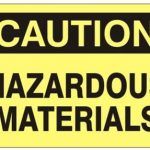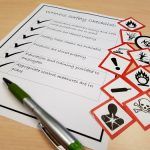
Why WHMIS Matters: How to Stay in Compliance for Hazardous Material Handling, Storage & Use

Effective and proper handling, use and storage of hazardous materials in the workplace is a matter of high priority for organizations large and small across Ontario & Canada. WHMIS exists to protect workers and to ensure that a culture of safety permeates every workplace.
In this article we’ll take a closer look at the need for WHMIS and discuss how your organization can benefit from not only being in compliance with WHMIS regulations but going above and beyond as well.
Background of WHMIS: Workplace Hazardous Materials Information System
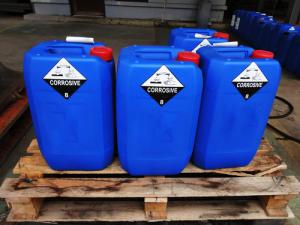 Workplace safety in Canada is of paramount importance. The Workplace Hazardous Materials Information System (WHMIS) is a crucial piece of the safety puzzle, ensuring the safety of workers, management, customers, stakeholders and the community. This essential safety system is the standard for hazardous materials handling, use and storage for all of Canada. This national standard was put in place in 1988 and has three important components.
Workplace safety in Canada is of paramount importance. The Workplace Hazardous Materials Information System (WHMIS) is a crucial piece of the safety puzzle, ensuring the safety of workers, management, customers, stakeholders and the community. This essential safety system is the standard for hazardous materials handling, use and storage for all of Canada. This national standard was put in place in 1988 and has three important components.
Proper Labeling
The first element of the system is to ensure proper labeling of containers with respect to hazardous materials. It is critical for workers to know what they are transporting or working with in the event of a problem. Step one in effective communication of hazardous materials is to know what is inside a container that someone is about to handle, use, transport or store. Once a worker is aware of the materials moving through a process, only then can specific handling procedures be followed.
Material Safety Data Sheets (MSDSs)
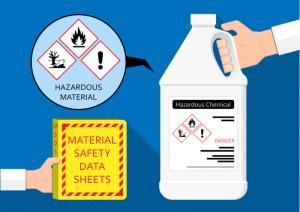 The second element of the system is to ensure material safety data sheets (MSDSs) accompany the containers or are readily available for workers to review. It is not enough to just be aware that a container is hazardous; an effective safety system must also communicate specifics on the type of material and how suppliers and workers should properly handle the container. The MSDS documentation provides the specific guidance needed to properly handle the material.
The second element of the system is to ensure material safety data sheets (MSDSs) accompany the containers or are readily available for workers to review. It is not enough to just be aware that a container is hazardous; an effective safety system must also communicate specifics on the type of material and how suppliers and workers should properly handle the container. The MSDS documentation provides the specific guidance needed to properly handle the material.
Training
The final essential component of the WHMIS is training. Training is an essential component of any system implementation, and even more so, when it comes to workplace safety. Workers need to understand the full scope of the WHMIS, and make sure they understand their responsibilities. WHMIS responsibilities are shared across workers, management, and the material suppliers. A key worker responsibility is to read the MSDS documentation before starting to work with hazardous materials. Management or ownership is responsible to work with suppliers to ensure that current information is provided from the supplier. Training, with a full understanding of the WHMIS responsibilities is key to the overall safety. And, as with any important government program, compliance (and therefore compliance training) is an important employer responsibility.
A Safe Environment and Community
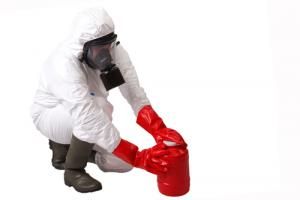 WHMIS is important for the protection of the workplace and potentially the surrounding area. Consider the impact of a large chemical spill or derailment event on the community near or around the facility where hazardous materials may be processed. To avoid this risk, mitigation steps must be in place; the WHMIS is a key part of the risk mitigation. WHMIS falls under the category of administrative controls. Controls are required by Canadian law (federal & provincial) to ensure there are standards for labeling, effective communication procedures and training.
WHMIS is important for the protection of the workplace and potentially the surrounding area. Consider the impact of a large chemical spill or derailment event on the community near or around the facility where hazardous materials may be processed. To avoid this risk, mitigation steps must be in place; the WHMIS is a key part of the risk mitigation. WHMIS falls under the category of administrative controls. Controls are required by Canadian law (federal & provincial) to ensure there are standards for labeling, effective communication procedures and training.
Controls are put in place for the protection to people and property. WHMIS exists to protect Canadian workers and citizens from the potentially harmful effects of hazardous materials. To effectively implement this type of safety control system requires communication in the form of labeling and safety data sheet and training. WHMIS is important because it helps keep Canadians safe from hazardous material risks.
If you have any doubts as to whether a particular measure or action is within WHMIS compliance, as they say it’s always better to err on the side of caution. That’s why we recommend that companies & organizations go above & beyond in your WHMIS efforts.
How Advanced Consulting & Training Can Help With WHMIS
Contact Advanced Consulting & Training today to find out how your company can operate at its most optimum WHMIS levels. We conduct WHMIS compliance training and seminars both at our location and onsite for clients.

